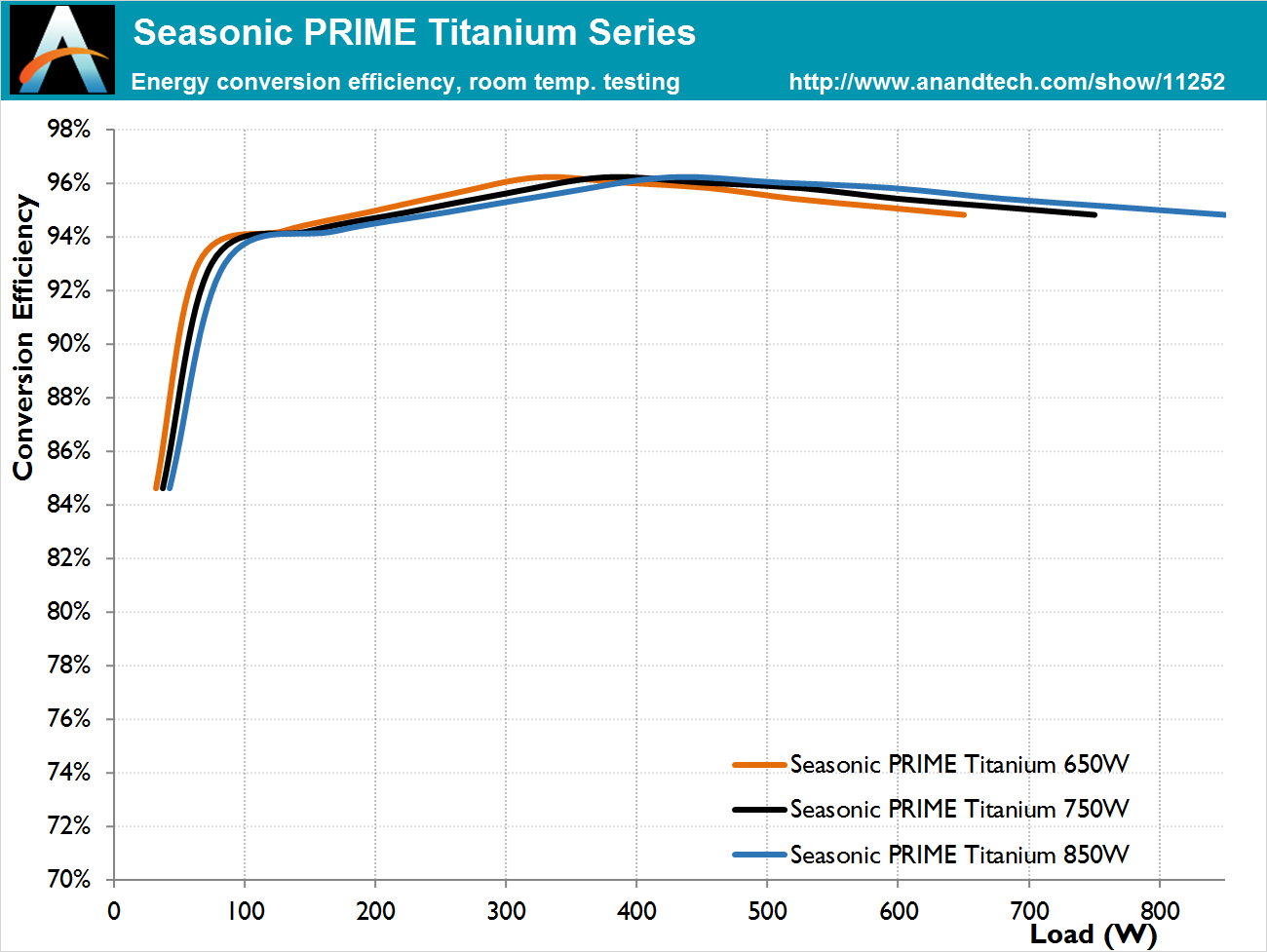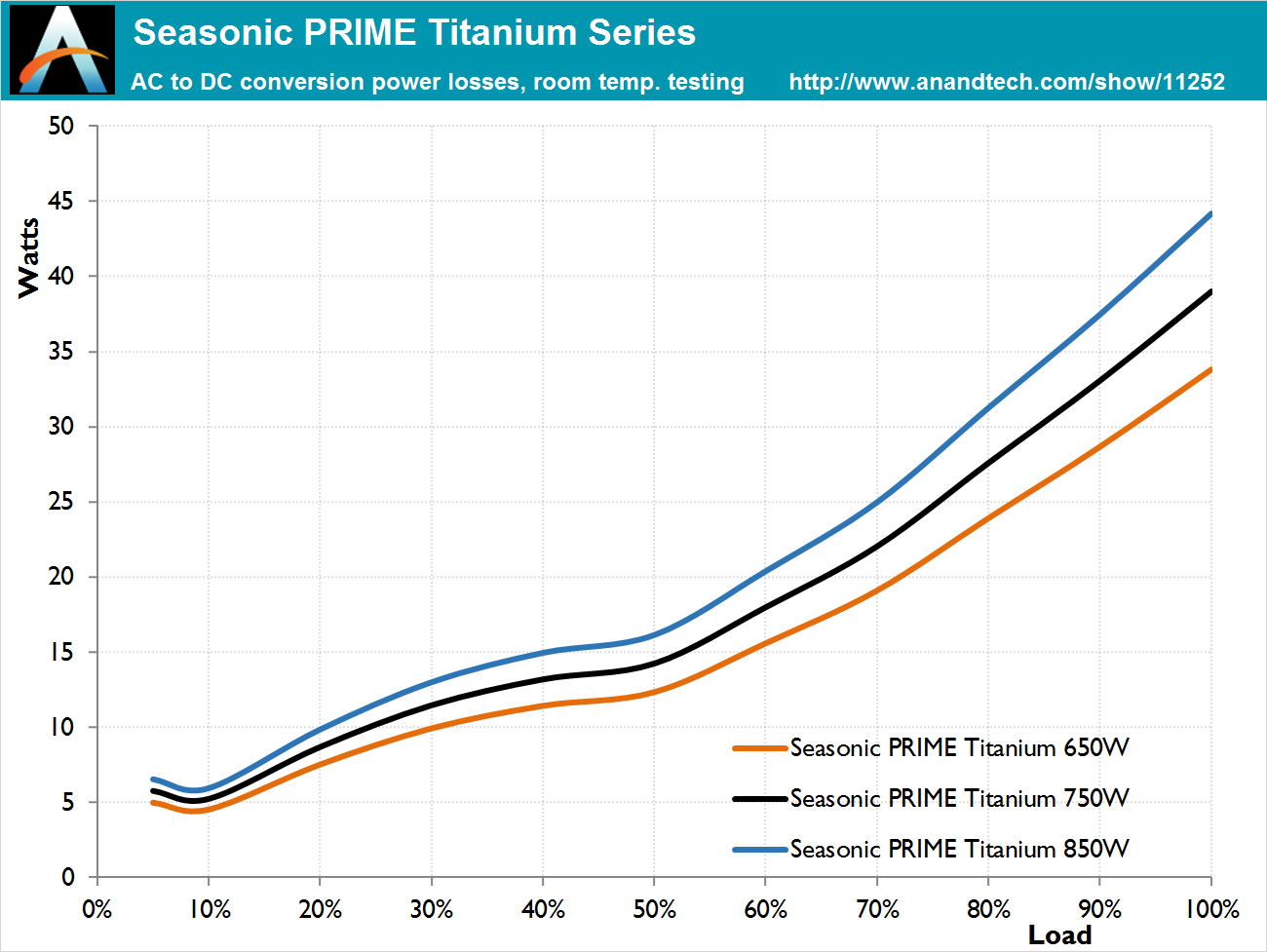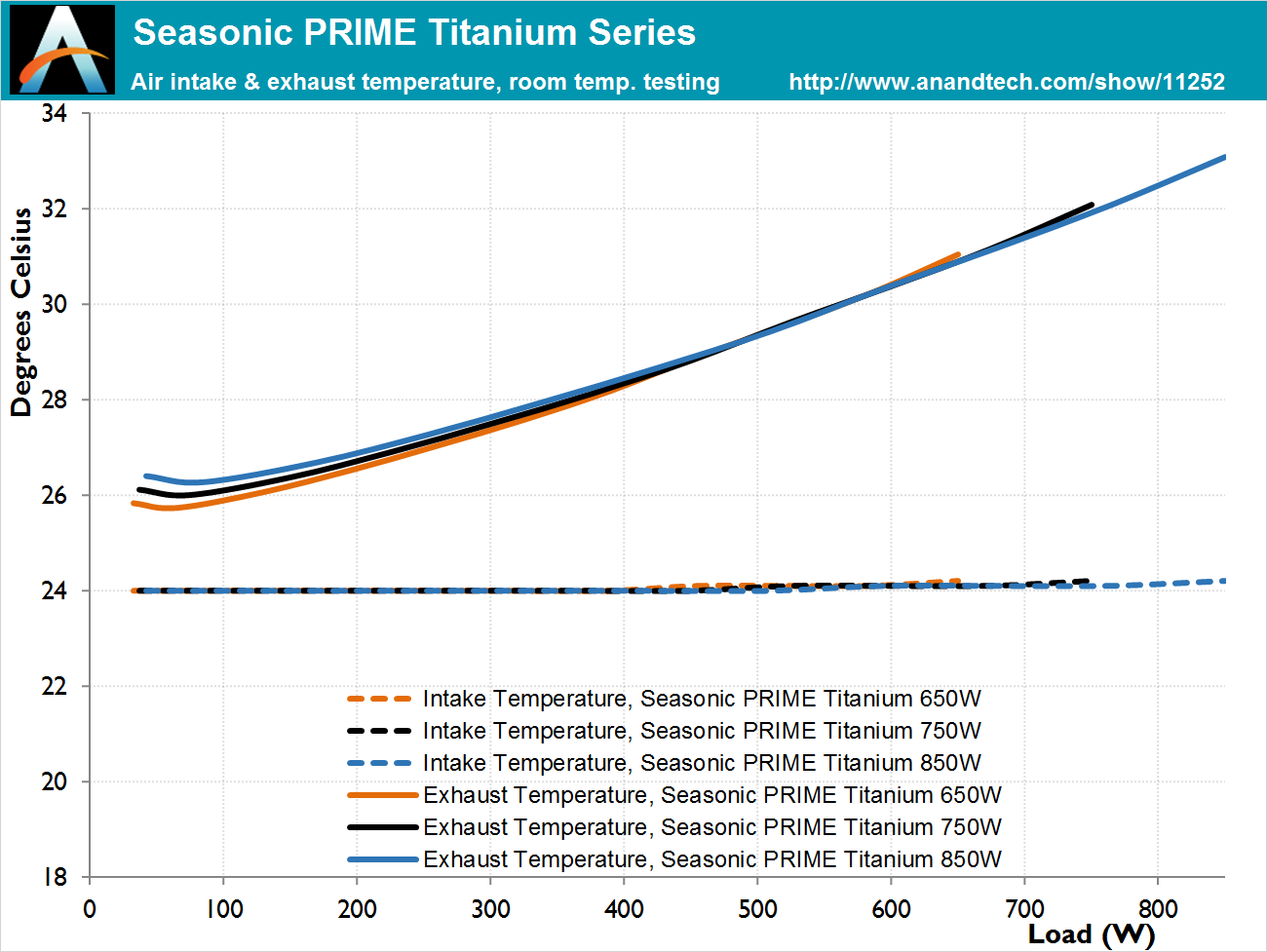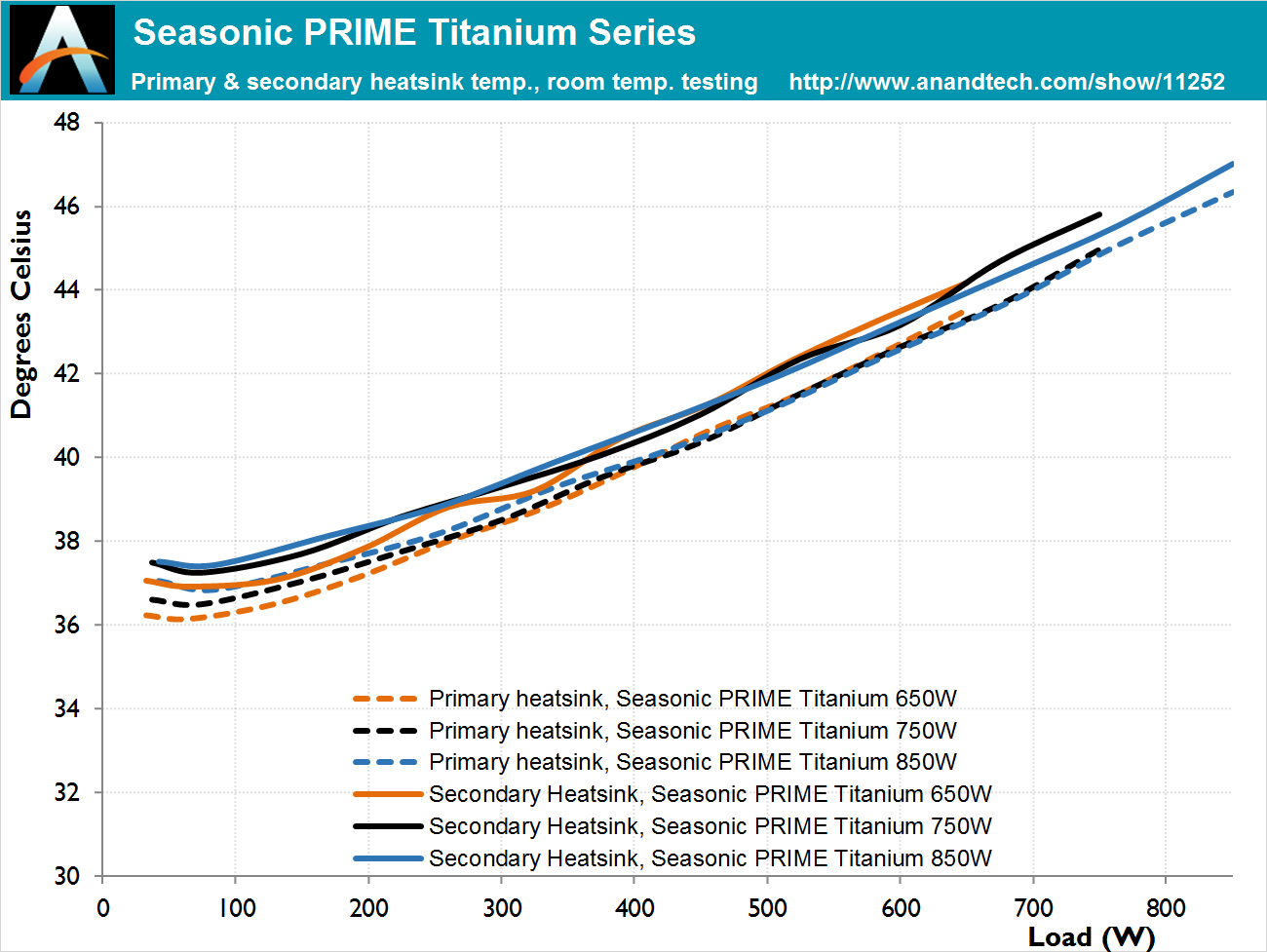The Seasonic PRIME Titanium PSU (650W, 750W, 850W) Review: Mythical Performance
by E. Fylladitakis on April 7, 2017 9:00 AM ESTCold Test Results
For the testing of PSUs, we are using high precision electronic loads with a maximum power draw of 2700 Watts, a Rigol DS5042M 40 MHz oscilloscope, an Extech 380803 power analyzer, two high precision UNI-T UT-325 digital thermometers, an Extech HD600 SPL meter, a self-designed hotbox and various other bits and parts. For a thorough explanation of our testing methodology and more details on our equipment, please refer to our How We Test PSUs - 2014 Pipeline post.
| Seasonic PRIME Titanium Efficiency (~25ºC Ambient Temperature Testing) |
||||
| % | Titanium Requirements (230AC) |
650TD | 750TD | 850TD |
| 10 | 90% | 93.1% | 93.2% | 92.9% |
| 20 | 94% | 94.2% | 94.2% | 94.1% |
| 50 | 96% | 96.3% | 96.2% | 96.1% |
| 100 | 91% | 94.8% | 94.8% | 94.8% |
We usually expect to see an 80Plus Titanium certified unit to borderline pass or even fail the certification requirements during our testing. This is because we are supplying 230V AC to the unit and most models have been optimized for an 110V AC input, as the certification requirements are significantly lower and makes it slightly easier for the designer to meet them. Seasonic positively surprised us because all three of the new PRIME Titanium units are extremely efficient, easily meeting the stricter 80Plus Titanium performance requirements with an input voltage of 230V AC. The top efficiency of all three units is ~96.2% when operating at 50% capacity, with a nominal load range (20%-100%) efficiency average of 95.1% (650W model) to 95.3% (750W/850W models). The low load efficiency with the PRIME Titanium PSUs operating at 10% capacity is above 84.5%, which is much higher than the peak efficiency many low-cost PSUs can hope to achieve. Still, the efficiency of the units once they reach 20% capacity is so high that the thermal losses actually seem to drop instead of increasing.
Please note that we had the hybrid fan mode disabled during our testing in order to showcase the low load noise levels with the fan turned on. With the hybrid mode turned on, the fan starts when the load reaches about 20-25% of the unit’s rated capacity.
The internal operating temperatures of the Seasonic PRIME Titanium are very low, which is to be expected with such an efficient design. The cooling fan initially appears to have a “ladder” behavior, increasing its speed in steps in relation to the load, but the thermal control circuit is actually linear. When the units are operating in an ambient temperature environment, the speed increases are just very small in relation to the fan’s operating range, which appears as a step-like behavior on a chart. The fan of any of the three units did not even reach 50% of its rated speed at maximum load under these operating conditions, operating way below its optimal range and barely reaching audible sound pressure level figures.
The hybrid fan mode is the only thing that does not make much sense with these three units. If the setting is set to off, the fan will start as soon as the PSU is powered on regardless of the load, but will still retain its minimum possible rotational speed until the thermal control circuit decides that it needs to spin faster. The fans of the PRIME Titanium units are inaudible when running at such low speeds. If the setting is turned on, the fans will start before the point they become audible with the setting turned off, meaning that there is no practical difference at low loads whether the fan is spinning or not. Considering that the fans of the units are inaudible when spinning at their minimum speed, it might be wise to keep the hybrid mode turned off. Lower operating temperatures can only increase the longevity of a PSU, even one as good as this one.















86 Comments
View All Comments
Jammrock - Friday, April 7, 2017 - link
I've had the 650W version since Oct 2016. It's powering an i7-6700K with a GTX 1080. Absolutely zero issues so far. It's quiet and efficient and solid. Can't recommend it enough. If the price tag fits within budget....My only gripe is the motherboard power cable. It's a split cable and kind of annoying to deal with. But then you only need to mess with it once per motherboard upgrade so really it's a very minor issue.
close - Friday, April 7, 2017 - link
Just out of curiosity, why didn't you go for the 750W if the price difference is just $5? Is it for efficiency reasons (less efficient than the 650W at your system's typical load)?Bullwinkle J Moose - Friday, April 7, 2017 - link
Low load efficiency was the reason I purchased a 350 Watt Seasonic SSR-350ST from newegg a few days ago instead of the SS-520GB or the SS-620GB @ B&H Photo for the same price when they were on sale last weekI wish you would cover power supply replacements for Monitors sometime
Had a standard 19 Volt LG power supply crap out last month and the only replacements I could find are basically CRAP
A T-Power replacement actually MELTED within 3 days and became non-functional before it had a chance to burn the house down
Other online stores for Monitor power supplies are complete scams selling more Chinese CRAP instead of the original equipment listed in their ads
I ended up using a VERY Old 120 Watt - 15 Volt Athena Laptop power supply with the T-Power Plug spliced to it's output
It works fine on 19 Volt LG's and cost about $30 around 10 years ago
I was a bit worried about EBay replacements for LG supplies but may need to try that route next time unless anyone knows where to buy "QUALITY" supplies with output current rated "above" what the stock LG's put out
Computer Power supplies are well covered at all the tech sites...
Monitor Supplies are never covered
Why is that?
Bullwinkle J Moose - Friday, April 7, 2017 - link
Modular cable outputs for 2 or 3 computer monitors on the back of these computer power supplies would be nice!I'd buy THAT!
alin - Friday, April 7, 2017 - link
Most laptop psu's are 18-20v. Plenty of them around :)Grimmm - Friday, April 7, 2017 - link
When I was overclocking a Korean IPS I bought a high power brick designed for medical applications on an online industrial parts catalog. Cost a bit, but works perfectly (after swapping the output connector)Jammrock - Tuesday, April 11, 2017 - link
@close - Two reasons. 1) At the time the 750W was more than a $5 difference. I purchased mine >6 months ago. 2) I try to size my PSUs to the load so they hit the peak of efficiency for the majority of my tasks. Granted, the difference is minimal for this particular 80Plus Titanium PSU, but old habits die hard.Sparkyman215 - Friday, April 7, 2017 - link
Wow. I've read a lot of your psu reviews, and I don't think you've used the words 'insanely good', 'unbelievable' - and of course 'mythical'. Even though the price is high, getting one of these and keeping it through upgrades for over a decade is probably a better deal than a lower end psu you have to replace several timesblahsaysblah - Friday, April 7, 2017 - link
It's pretty disheartening to think that they wont be modernizing either the cable layout/connectors or any other aspect of the PSU. It would be great if they could make things smaller/more direct. With the move to a single 12v rail, you would think they would move to single hot/ground per CPU/GPU connector. They have changed the insides a bit. Why there isnt some sort of data/status connector between PSU and MB... At very least to communicate PSU temps, but to add voltage,.. info, instead of all those sense cables.JasperJanssen - Saturday, April 8, 2017 - link
Moving to single wire bundles wouldn't gain you anything, and in fact loses you things. The reason there's 2 or 3 wires in those pcie bundles is current capability -- both for the connector and for the wires. So you still need the same amopunt of copper (actually, slightly more) to do that, if you move to having single wires instead of doubled. but those wires are going to be stiffer and more expensive. In other words, that's a bad idea.And re Status connectors -- while Seasonic could unilaterally add something custom, how many motherboard companies do you think would put a matching connector on? Also, the only thing that even *can* be monitored inside a PSU is the fan speed. That's why they occasionally had a fan speed wire coming out, which you can put on a motherboard fan connector. Only nobody ever used that function.
There just isn't any digital logic inside a PSU to communicate with. Motherboards can monitor voltages just fine on their own through the ATX connector.
(also, changing the connector type requires changing both the power supply *and* the GPU, which is awful.)